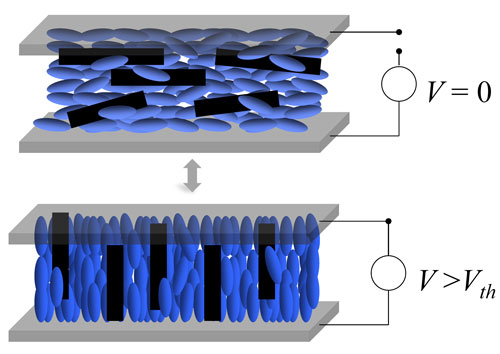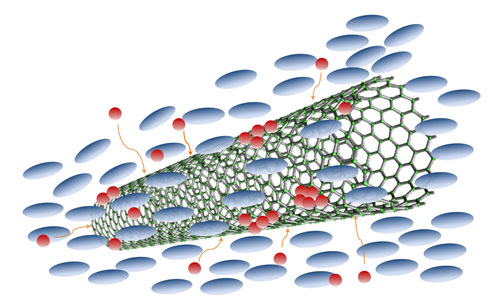| Posted: Dec 13, 2013 | |
Carbon nanotube-doped liquid crystals result in faster LCDs |
|
| (Nanowerk Spotlight) Liquid crystals (LCs) exhibit a phase of matter that has properties between those of a conventional liquid and those of a solid crystal. This means that LCs can flow like a liquid, and at the same time the anisotropic LC-molecules maintain a long range crystalline order. Their unique combinations of liquid and solid-like properties allow liquid crystals to be used pervasively in the electro-optical display technology – known as liquid crystal display (LCD). | |
| In new work, researchers have observed that a dilute suspension of a small amount of multi-walled carbon nanotubes (MWCNTs) in a nematic LC (in the nematic LC phase the molecules are oriented in parallel but not arranged in well-defined planes) results in a significantly faster nematic switching effect on application of an electric field. | |
| Rajratan Basu, an Assistant Professor in the Department of Physics at the United States Naval Academy, has recently shown that when a small amount of carbon nanotubes is doped in a nematic LC, the LC+MWCNT matrix shows a faster response to an electric field compared to that of the pure LC. This accelerated response could be used to develop faster LCDs. | |
| Basu reported his findings in the December 10, online edition of Applied Physics Letters ("Effect of carbon nanotubes on the field-induced nematic switching"). | |
| The MWCNTs, embedded in the LC matrix, follow the LC reorientation, enhancing the overall dielectric anisotropy of the system, shown in Fig. 1. | |
 |
|
| Fig. 1: Schematic representation of liquid crystals (ellipsoids) and carbon nanotubes (black rods) reorientation under an external electric field. (Image: Rajratan Basu, U.S. Naval Academy) | |
| The obvious question is: why does the presence of carbon nanotubes significantly reduce the field-induced nematic switching time? | |
| "In general, liquid crystals contain a significant amount of free ions," Basu explains to Nanowerk. "The presence of ions results in an increase in rotational viscosity, slowing down the director’s response to an external field. The MWCNTs in the media act as ion-catchers with a high ion-trapping coefficient." | |
| Thus, the MWCNTs, being suspended in the system, lower the free ion concentration, decreasing the rotational viscosity for the overall system as illustrated in Fig. 2. | |
 |
|
| Fig. 2: Schematic representation of ion (red spheres) trapping process of a carbon nanotube embedded in a liquid crystal (ellipsoids) mediated platform. (Image: Rajratan Basu, U.S. Naval Academy) | |
| With a lower rotation viscosity and enhanced dielectric anisotropy the hybrid system shows an accelerated response to the electric field. | |
| Basu now plans to conduct a MWCNT-concentration dependent study to investigate the threshold limit of the concentration above which the system no longer switches faster. | |
 By
Michael
Berger
– Michael is author of three books by the Royal Society of Chemistry:
Nano-Society: Pushing the Boundaries of Technology,
Nanotechnology: The Future is Tiny, and
Nanoengineering: The Skills and Tools Making Technology Invisible
Copyright ©
Nanowerk LLC
By
Michael
Berger
– Michael is author of three books by the Royal Society of Chemistry:
Nano-Society: Pushing the Boundaries of Technology,
Nanotechnology: The Future is Tiny, and
Nanoengineering: The Skills and Tools Making Technology Invisible
Copyright ©
Nanowerk LLC
|
|
|
Become a Spotlight guest author! Join our large and growing group of guest contributors. Have you just published a scientific paper or have other exciting developments to share with the nanotechnology community? Here is how to publish on nanowerk.com. |
|
